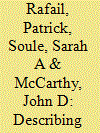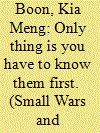| Srl | Item |
| 1 |
ID:
113953


|
|
|
|
|
| Publication |
2012.
|
| Summary/Abstract |
Numerous scholars have observed a decline in more coercive police tactics used to control demonstrations since the 1960s in North America and Western Europe. Such claims, however, are largely based on rather unsystematic observation, and almost no research directly examines the evolution of protest policing during this entire period. To address this gap, the authors use semiparametric logistic regression to examine reported police presence, the use of arrests, and the use of force at 15,965 US protests occurring between 1960 and 1995. The results confirm that while there has been an absolute decline in more repressive policing behavior, the transitional process was not a monotonic, linear process. The authors also investigate the different evolutionary patterns of each type of protest policing. The authors further demonstrate that African American initiated events, government targets, social movement organization presence, protest forms, the use of force, and arrests have variable impacts on police responses over time.
|
|
|
|
|
|
|
|
|
|
|
|
|
|
|
|
| 2 |
ID:
185080


|
|
|
|
|
| Summary/Abstract |
This article critically examines the models of protest policing deployed by the Malaysian police during the BERSIH 2.0 wave of protests (2011–2016). Based on participant observation and critical ethnography of these protest events, it explains how the state and police adapted to the surge of street protests in Kuala Lumpur by bringing together various elements of policing practices in its attempt to contain dissent on the streets. I argue that the new ‘Peaceful Assembly assemblage’ of policing practices, though distinct and significantly different in its overall governing logic compared to its predecessor, it remains heavily connected to late colonial forms of public order and counterinsurgent policing, especially the Special Branch and the Federal Reserve Unit (riot police). In this sense, the article shows that colonial policing’s afterlife is a major factor for understanding how Malaysia’s protest policing experience complicates and departs from patterns of protest policing development observed in the Global North.
|
|
|
|
|
|
|
|
|
|
|
|
|
|
|
|